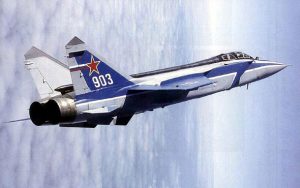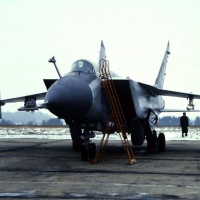MiG-31 Foxhound
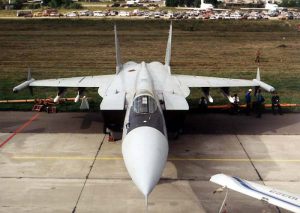 As one of the later models following a long line of successful Soviet- manufactured aircraft, the Mig-31 Foxhound is an all-weather interceptor plane which entered service in Russia possibly as early as 1976. Touted as the forerunner to the MiG-23, Su-15, and the MiG-25, the Foxhound “B” was endowed with the capacity for two fliers, supersonic velocity close to three times the speed of sound, dual turbofan afterburners, and folding wings. Its aerodynamic design includes a high degree of slope and twin outward cantered fins. As a highly-refined aircraft, the current versions of the MiG-31 have introduced many technical innovations to its various combat theatres. The complex electronically-scanned phased array-type Zaslon radar, along with its now-standard conical radome reside in the pointed front end of the plane. Also standard to MiGs are radar warning receivers and several antennae, capable of pursuing signals via VHF, the IFF system, and information drawn in through its vanes and yaws. The MiG’s arsenal is not spectacular in proportion to its contemporaries, yet it is equivalent. Attached to its pylons are the AA-8 Aphid K-60 and AA-9 R-33 air-to-air missiles, the latter known to the North American Treaty Organization as the “Amos”. R-40T Acrid medium-range infrared weapons as well as additional Amos missiles are housed on the plane’s exterior, with the now ever-present Gsh-6-23 six-barrel Gatling gun which fires 23-millimeter projectiles. Composition for the aircraft is of vital importance, especially when reaching high altitudes or rapidity. Devices on the craft to prevent the lethal accumulation of static are present, as well as tough, heavier alloys comprising 33 per cent of the makeup of the craft’s frame. Half of the skeleton of the plane is made of nickel, and another 16% of it consists of the light, durable, heat-resistant element, titanium. Russia’s Nizhny Novgorod facility, called by some American insiders “the fox works”, is the current producer of the craft, and reportedly 160 occupy CIS interceptor air forces.
As one of the later models following a long line of successful Soviet- manufactured aircraft, the Mig-31 Foxhound is an all-weather interceptor plane which entered service in Russia possibly as early as 1976. Touted as the forerunner to the MiG-23, Su-15, and the MiG-25, the Foxhound “B” was endowed with the capacity for two fliers, supersonic velocity close to three times the speed of sound, dual turbofan afterburners, and folding wings. Its aerodynamic design includes a high degree of slope and twin outward cantered fins. As a highly-refined aircraft, the current versions of the MiG-31 have introduced many technical innovations to its various combat theatres. The complex electronically-scanned phased array-type Zaslon radar, along with its now-standard conical radome reside in the pointed front end of the plane. Also standard to MiGs are radar warning receivers and several antennae, capable of pursuing signals via VHF, the IFF system, and information drawn in through its vanes and yaws. The MiG’s arsenal is not spectacular in proportion to its contemporaries, yet it is equivalent. Attached to its pylons are the AA-8 Aphid K-60 and AA-9 R-33 air-to-air missiles, the latter known to the North American Treaty Organization as the “Amos”. R-40T Acrid medium-range infrared weapons as well as additional Amos missiles are housed on the plane’s exterior, with the now ever-present Gsh-6-23 six-barrel Gatling gun which fires 23-millimeter projectiles. Composition for the aircraft is of vital importance, especially when reaching high altitudes or rapidity. Devices on the craft to prevent the lethal accumulation of static are present, as well as tough, heavier alloys comprising 33 per cent of the makeup of the craft’s frame. Half of the skeleton of the plane is made of nickel, and another 16% of it consists of the light, durable, heat-resistant element, titanium. Russia’s Nizhny Novgorod facility, called by some American insiders “the fox works”, is the current producer of the craft, and reportedly 160 occupy CIS interceptor air forces.
Designed as a long-range, extended-endurance PVO interceptor to replace the Tu-128 ad MiG-25. Development began in 1967 and the S-155MP avionics complex was ordered for the Ye-155MP interceptor in 1968. First flown, as Ye-155MP (originally Type 83 MiG-25MP) “831”, 16 September 1975; second prototype (“832”), with radar, first flew 22 April 1976. Two preproduction aircraft (011 and 012) built by Sokol and flown 13 July and 30 June 1977; six development aircraft (201 to 203 and 301 to 303). Full production (of about 450) started 1979; first of 11 regiments operational 1983, replacing MiG-23s and Su-15s; production has ceased at Sokol Aircraft Building Plant (formerly GAZ-21), Nizhny Novgorod, though the Sokol plant has stated its willingness to reinstate production to meet even small orders. Mikoyan is offering modernisation programme to bring in-service MiG-31s to MiG-31M levels of capability, including integration of R-37 AAM.
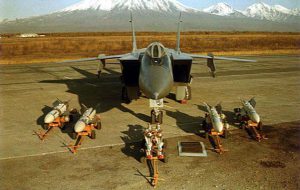 Initiated to counter threat of USAF B-52 bombers carrying ALCMs. Basic MiG-25 configuration retained, but very different aircraft, with two seats; strengthened to permit supersonic flight at low altitude; more powerful engines than MiG-25; major requirement increased range, not speed; advanced digital avionics; Zaslon radar was first electronically scanned phased-array type to enter service, enabling MiG-31 to track 10 targets and engage four simultaneously, including targets below and behind its own location; fuselage weapon mountings added. Wing anhedral 4º from roots; sweepback approximately 41º on leading-edge, 32º at quarter-chord, with small, sharply swept wingroot extensions; all-swept tail surfaces, with twin outward-canted fins and anhedral on horizontal surfaces.
Initiated to counter threat of USAF B-52 bombers carrying ALCMs. Basic MiG-25 configuration retained, but very different aircraft, with two seats; strengthened to permit supersonic flight at low altitude; more powerful engines than MiG-25; major requirement increased range, not speed; advanced digital avionics; Zaslon radar was first electronically scanned phased-array type to enter service, enabling MiG-31 to track 10 targets and engage four simultaneously, including targets below and behind its own location; fuselage weapon mountings added. Wing anhedral 4º from roots; sweepback approximately 41º on leading-edge, 32º at quarter-chord, with small, sharply swept wingroot extensions; all-swept tail surfaces, with twin outward-canted fins and anhedral on horizontal surfaces.
Airframe 49 per cent arc-welded nickel steel, 16 per cent titanium, 33 per cent light alloy; 2 per cent composites, including radome; three-spar wings; no wingtip fairings or mountings; small forward-hinged airbrake under front of each intake trunk; undersurface of centre-fuselage not dished between engine ducts like MiG-25; much enlarged air intakes; jet nozzles extended rearward; shallow fairing extends forward from base of each fin leading-edge; fence above each wing in line with stores pylon.
Pilot and weapon systems operator in tandem under individual rearward-hinged canopies; rear canopy has only limited side glazing and blends into shallow dorsal spine fairing which extends to forward edge of jet nozzles.
Large-span ailerons and flaps; leading-edge slats in four sections on each wing; all-moving horizontal tail surfaces; inset rudders.
Two Aviadvigatel D-30F6 turbofans, each 93.1 kN (20,930 lb st) dry, 151.9 kN (34,170 lb st) with afterburning; internal fuel capacity 19,940 litres (5,268 US gallons; 4,386 Imp gallons) in seven fuselage tanks, four wing tanks and two fin tanks. Provision for two underwing tanks, each 2,500 litres (660 US gallons; 550 Imp gallons); semi-retractable flight refuelling probe on port side of front fuselage.
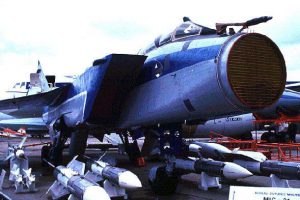 Comms: R-862 UHF, R-864 HF, P-591 voice warning system, SPU-9 intercom; SRO-2P IFF transmitter and SRZ-2P receiver; SO-69 transponder. Radar: NIIP N007 S-800 SBI-16 (RP-31) Zaslon or Zaslon-A electronically scanned phased-array fire-control radar (NATO “Flash Dance”) in nose; search range of 108 n miles (200 km; 124 miles) in clutter-free forward sector; range in rear sector 48 n miles (90 km; 56 miles); capable of tracking 10 targets and attacking four simultaneously. Flight: A312 Radikal-NP or A-331 Shoran, A-723 Kvitok-2 Loran. Marshrut long-range and Tropik medium-range nav systems. ARK-19 radio compass, RV-15 radar altimeter, RPM-76 marker beacon receiver. Mission: In four-aircraft group interception mission, only lead MiG-31 is linked to AK-RLDN automatic guidance network on ground; other three MiG-31s have APD-518 digital datalink to lead aircraft, permitting line-abreast radar sweep of zone 430 to 485 n miles (800 to 900 km; 495 to 560 miles) wide by 140º sector scanning angles. Semi-retractable Type 8TP IR search/track sensor under cockpit; tactical situation display. BAN-75 command link; APD-518 digital air-to-air datalink; Raduga-Bort-MB5U15K air-to-ground tactical datalink; SPO-155L RHAWS; Argon-15 digital computer.
Comms: R-862 UHF, R-864 HF, P-591 voice warning system, SPU-9 intercom; SRO-2P IFF transmitter and SRZ-2P receiver; SO-69 transponder. Radar: NIIP N007 S-800 SBI-16 (RP-31) Zaslon or Zaslon-A electronically scanned phased-array fire-control radar (NATO “Flash Dance”) in nose; search range of 108 n miles (200 km; 124 miles) in clutter-free forward sector; range in rear sector 48 n miles (90 km; 56 miles); capable of tracking 10 targets and attacking four simultaneously. Flight: A312 Radikal-NP or A-331 Shoran, A-723 Kvitok-2 Loran. Marshrut long-range and Tropik medium-range nav systems. ARK-19 radio compass, RV-15 radar altimeter, RPM-76 marker beacon receiver. Mission: In four-aircraft group interception mission, only lead MiG-31 is linked to AK-RLDN automatic guidance network on ground; other three MiG-31s have APD-518 digital datalink to lead aircraft, permitting line-abreast radar sweep of zone 430 to 485 n miles (800 to 900 km; 495 to 560 miles) wide by 140º sector scanning angles. Semi-retractable Type 8TP IR search/track sensor under cockpit; tactical situation display. BAN-75 command link; APD-518 digital air-to-air datalink; Raduga-Bort-MB5U15K air-to-ground tactical datalink; SPO-155L RHAWS; Argon-15 digital computer.
| MiG-31 Foxhound Specification | ||
| Prime contractor: | Mikoyan-Gurevich Design Bureau | |
| Country of origin: | Soviet Union | |
| Function: | Strategic interceptor fighter | |
| Crew: | 2 | |
| Year: | 1975 | |
| In-service year: | 1982 | |
| Engine: | Two Aviadvigatel D-30F6 afterburning turbofans | |
| Thrust: | 34,100 lb. each | 15,500 kg. each |
| Dimensions | ||
| Wing span: | 44 ft. 1 in. | 13.46 m. |
| Length: | 74. ft 4 in. (including nose probe) | 22.69 m. (including nose probe) |
| Height: | 20 ft. 2 in. | 6.15 m. |
| Weight: | ||
| Empty | 48,015 lb. | 21,825 kg. |
| Max. takeoff | 101,640 lb. | 46,200 kg. |
| Performance | ||
| Ceiling: | 67,568 ft. | 20,600 m. |
| Speed: | 1,863 mph | 3000 km/h |
| Range: | 1,326 miles (on internal fuel) 2,050 miles (with fuel drop tanks, no missiles) |
2,135 km. (on internal fuel) 3,300 km. (with fuel drop tanks, no missiles) |
| Armament | ||
| One GSh-6-23 six-barrel Gatling-type 23mm cannon with 260 rounds. Max. external weapons load (FE version) of 9,000 kg. (19,800 lb.) including R-33 (“AA-9 Amos”), R-40TD (“AA-6 Acrid”), R-77 RVV-AE (“AA-12”) AAMs., Kh-31P-31A (“AS-17 Krypton”), Kh-25MP-25MPU (“AS-12 Kegler”), Kh-29L/T (“AS-14 Kedge”), Kh-59 (“AS-13 Kingbolt”), Kh-59M (“AS-18 Kazoo”) ASMs., KAB-500, KAB-1500 guided bombs, FAB-1500 unguided bombs. Typical interceptor configuration: Four R-33 (AA-9 “Amos”), two R-40T (AA-6 “Acrid”), or four R-60 (AA-8 “Aphid”) AAMs. |
||
| Known Variants | ||
| MiG-31B, MiG-31BM, MiG-31BS, MiG-31D, MiG-31E, MiG-31EH, MiG-31F, MiG-31FE, MiG-31LL, MiG-31M, MiG-31MF, MiG-31S | ||
| Operators | ||
| Russia | ||
| Aircraft’s Price | ||
| 1997 – est. $57-60 millions. | ||
